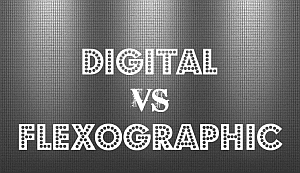How Much Label Market Share will Digital Take From Flexo?
From the dawn of time people have been sticking labels on everything. Whether it was a warning label, a notice, a direction, instructions, or a listing of contents, the labeling of products and everything else, has been part of the human psyche for organization and information for just about forever. And while traditional flexo has been the market leader digital printing is growing.sch is the flexo vs digital markets for pressure sensitive labels.
Just look around and you will see labels on anything. There is not a product sold in a supermarket or store that does not have a pressure sensitive label. In particular with food and chemicals. The good news is that these labels allow us to determine differences in products with ease.
Labels provide us with function and form but often times can be an eye sore. With a little ingenuity and passion, new ideas and processes can make improvements in labeling for what may be bigger, better and less expensive.
Two Types of Labels Flexo vs Digital
In the label world, the question between flexo vs digital is which form of pressure sensitive labels has become which form will win the war of market share? While the future is still unknown, here is what we do know about the two types:
Digital Labeling
Digital printing first appeared around 1985 and in the first 20 years, had taken hold of 9% of the commercial market share. That may not sound like a high percentage, but with all the types of printing vying for market share, this 9% is significant.
Commercial digital printing takes toner, and with an electrical charge, transfers the printing image to the paper or medium to be printed. Digital printing is faster and more efficient. It has provides the following additional benefits that make it a preference for many:
Due to advanced computerization and graphics, the setup and turn around time is shorter with digital printing
◆ Digital printing is precise making each print an exact copy of the original
◆ With smaller volumes, the cost is quite competitive to other forms, and in fact, may be less expensive due to it being faster and easier to set up
◆ It is easy to vary the printing information by using attached databases, such as printing personalized invitations or for businesses, a personal call to action thus being widely adopted by the direct marketing industry
We now see digital printing in our homes, in our office, and in the commercial printing industry. But when it comes to flexo vs digital in market trends, the tried, true and tradition, still have some “cards up their sleeve” that in some cases may still make it the best printing choice.
Traditional Flexo Labeling
Traditional flexo labeling allows for the printing on just about any type of material, from paper, to plastic, and including wood, metal, or just about anything that one can think of to print on.
 The name “flex” implies flexibility, and with the relief plates used in this type of printing, that is exactly what they do. In some circumstances and applications, a relief plate can be placed directly on the medium to be printed and with only pressure. No ink needed, but an ink print can be transferred.
The name “flex” implies flexibility, and with the relief plates used in this type of printing, that is exactly what they do. In some circumstances and applications, a relief plate can be placed directly on the medium to be printed and with only pressure. No ink needed, but an ink print can be transferred.
To get a simple idea how this works, think about a small printing block with raised letters and areas that are not to be printed are recessed. That printing block is a simple relief plate. The voids don’t take on the ink or transferring any image to the medium. There are still some significant advantages of Traditional Flexo Printing that keep it in the fight of flexo vs digital. Some of these advantages are:
◆ A variety of ink types can be used for printing, which gives the end user opportunities for different looks and feel for printing, compared to digital printing, which use only one form
◆ Many different surfaces can be printed on with Flexo Printing, where digital printing is limited in application for non-standard printing mediums
◆ The cost for late printing jobs is more than competitive compared to digital printing
◆ In food grade printing, Flexo Printing allows the use of vegetable based inks, making labels safer for this type of application
◆ Flexo Printing can better handle solid color printing, as well as continuous pattern printing
What to go with?
 The question of how much market share will digital printing take from Traditional Flexo Printing is difficult to quantify.
The question of how much market share will digital printing take from Traditional Flexo Printing is difficult to quantify.
The more important thing to consider in flexo vs digital is that both have their place in servicing the needs of the customer and one size does not fit all.
Digital Printing will probably maintain its hold of 9% of its market share and may even increase that share as technology advances even further.
But, there are still some real reasons to use Traditional Flexo Printing, and these reasons, or advantages, will be there for a long time to come in the flexo vs digital wars of printing labels.
